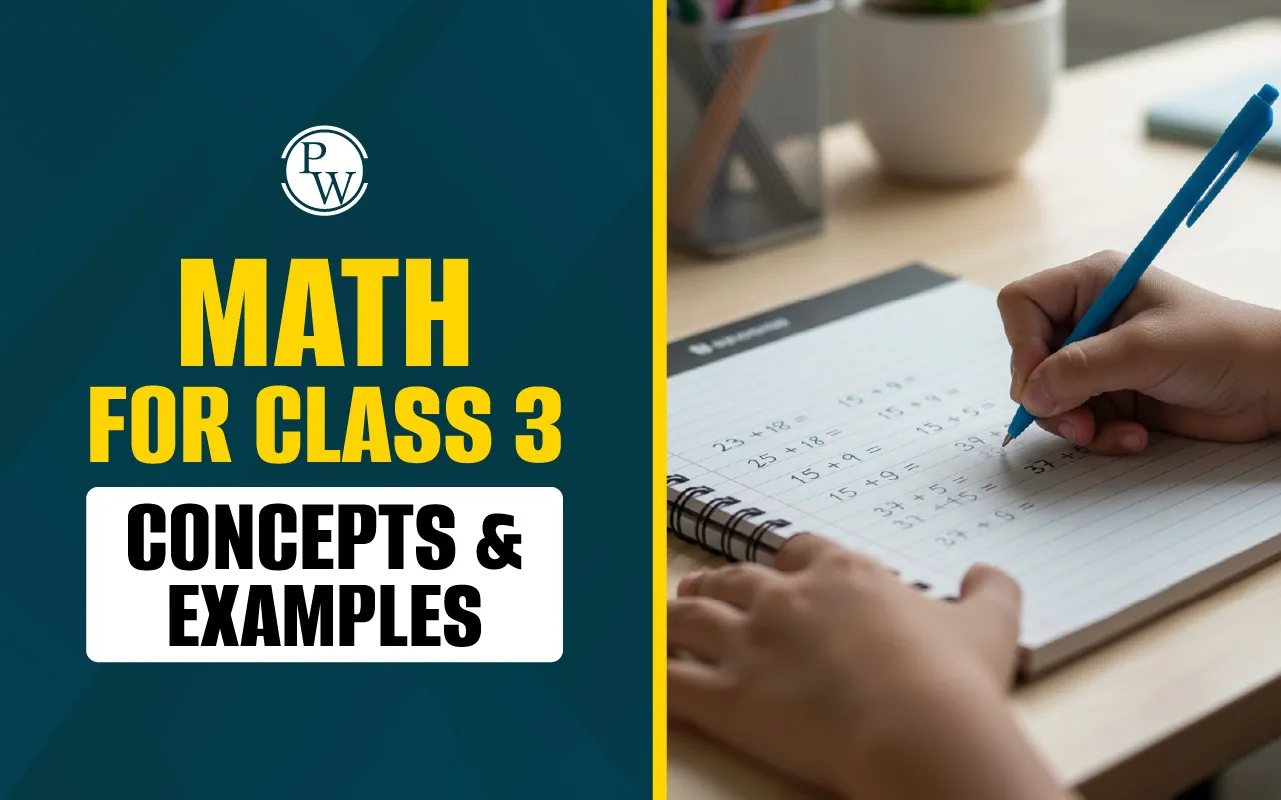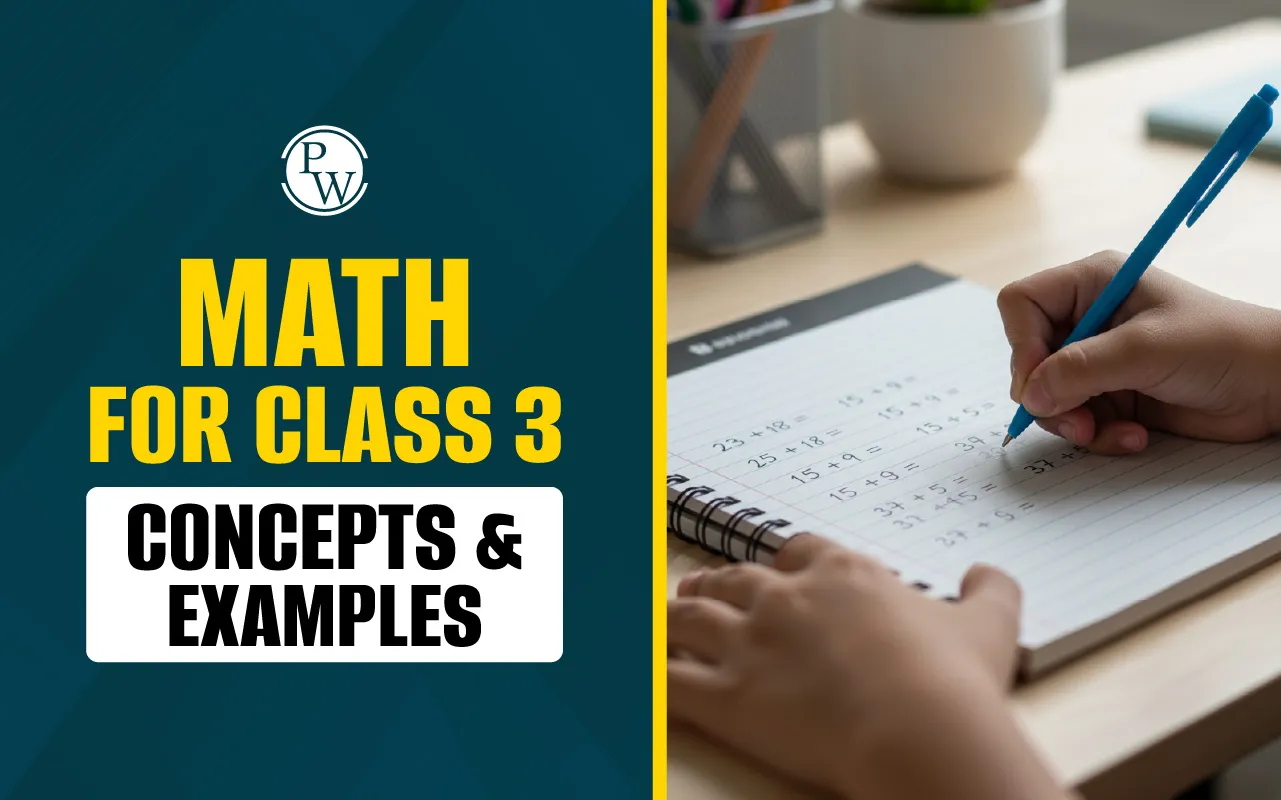

Maths For Class 3
Class 3 Maths helps children understand how numbers, shapes, and patterns work in everyday life. At this stage, they move beyond simple sums and start solving word problems, using logic and reasoning.
The Class 3 Math syllabus introduces larger numbers, basic geometry, fractions, time, money, and measurements. It encourages students to apply what they learn in real situations, developing confidence, problem-solving skills, and a solid foundation for higher classes.
Maths Class 3 Syllabus
The Class 3 Math syllabus consists of twelve important chapters. Each chapter builds on the concepts learned in earlier grades and prepares students for more advanced learning in the future. Below is a list of the topics covered in each chapter..
1. Large Numbers
Children are introduced to 4-digit numbers and learn how to read and write them correctly. They explore the concept of place value (ones, tens, hundreds, and thousands) and face value of digits.
Topics covered:
-
Reading and writing 4-digit numbers
-
Comparing and arranging numbers
-
Expanded and standard forms
-
Successor and predecessor
-
Rounding off numbers to the nearest ten and hundred
-
Roman numbers
-
Even and odd numbers
2. Addition
Addition teaches how to combine numbers and find totals. Students learn to add 3-digit and 4-digit numbers using the column method.
Topics covered:
-
Addition facts
-
Adding numbers with and without regrouping
-
Estimating sums
-
Word problems and story sums
3. Subtraction
Subtraction focuses on finding differences and understanding how much one quantity is less than another.
Topics covered:
-
Subtraction without borrowing
-
Subtraction with regrouping
-
Estimating the difference
-
Solving subtraction story sums
4. Multiplication
Students learn multiplication as repeated addition. Tables up to 20 are revised regularly.
Topics covered:
-
Multiplication tables up to 20
-
Multiplying 2-digit and 3-digit numbers by single-digit numbers
-
Multiplying 2-digit numbers by 2-digit numbers
-
Story sums using multiplication
5. Division
Division introduces the concept of equal sharing or grouping. It is the reverse of multiplication.
Topics covered:
-
Equal grouping
-
Division using multiplication tables
-
Division with and without remainder
-
Checking division through multiplication
-
Story sums
6. Patterns and Symmetry
Patterns teach how numbers, shapes, and colours can repeat in an organised way. Symmetry helps children understand balance in design.
Topics covered:
-
Repeating patterns
-
Number patterns
-
Symmetrical shapes
-
Mirror images
7. Fractions
Fractions help children understand parts of a whole and comparison of equal parts.
Topics covered:
-
Fractions of a whole
-
Proper fractions and improper fractions
-
Comparing fractions
-
Fractions of a collection
8. Geometry
Geometry introduces shapes, lines, and angles that children see every day.
Topics covered:
-
Point, line, and line segment
-
Rays and angles
-
Plane and solid figures (cube, cuboid, cylinder, sphere, cone)
9. Measurement
Measurement teaches how to compare and calculate length, weight, and capacity.
Topics covered:
-
Measuring length (centimetres, metres, kilometres)
-
Measuring weight (grams, kilograms)
-
Measuring capacity (litres, millilitres)
-
Adding and subtracting measurements
10. Time
Understanding time is essential for daily routines.
Topics covered:
-
Reading hours and minutes on clocks
-
Using a.m. and p.m.
-
Days, months, and years
-
Converting time units
11. Money
Money lessons teach children how to count and manage real transactions.
Topics covered:
-
Units of money (₹ and paise)
-
Converting paise into rupees and vice versa
-
Addition and subtraction of money
-
Making bills and receipts
12. Data Handling
Data handling teaches students to collect, arrange, and read information from simple charts.
Topics covered:
-
Reading pictographs and bar graphs
-
Tally marks
-
Representing simple data visually
Class 3 Maths Examples
Here are some quick Class 3 Maths examples that teachers and parents can use for revision. These examples are designed to help children apply what they have learned in different chapters of the Class 3 Math syllabus.
1. Riya has 2,356 marbles and Tara has 1,248 marbles. How many marbles do they have altogether?
Number of marbles Riya has: 2,356
Number of marbles Tara has: 1,248
Total marbles = 2,356 + 1,248 = 3,604
They have 3,604 marbles altogether.
2. A shopkeeper had some pencils and sold a few. How many are left?
Number of pencils the shopkeeper had: 9,250
Number of pencils sold: 4,675
Pencils left = 9,250 − 4,675 = 4,575
The shopkeeper has 4,575 pencils remaining.
3. Each packet contains 24 chocolates. How many chocolates are there in 6 packets?
Chocolates in one packet: 24
Number of packets: 6
Total chocolates = 24 × 6 = 144
There are 144 chocolates in total.
4. There are 42 students and 7 benches in a class. How many students sit on one bench?
Number of students: 42
Number of benches: 7
Students on each bench = 42 ÷ 7 = 6
6 students sit on each bench.
5. A pizza has 12 slices. One-fourth of it is eaten. How many slices were eaten?
Total slices of pizza: 12
Fraction eaten: ¼
Slices eaten = ¼ of 12 = 12 ÷ 4 = 3
3 slices of pizza were eaten.
6. A ribbon is 5 metres long. How many centimetres long is it?
Length of ribbon in metres: 5 m
1 metre = 100 cm
Total length in centimetres = 5 × 100 = 500 cm
The ribbon is 500 centimetres long.
Read More: Maths Puzzles
Class 3 Maths Practice Questions
Here are some Class 3 Maths practice questions based on different chapters from the Class 3 Math syllabus. These can be used for revision or quick practice at home or in school.
-
Write the expanded form of 4,562.
-
Add 2,345 and 1,678.
-
Subtract 2,736 from 5,492.
-
Multiply 23 by 7.
-
Divide 56 by 8.
-
Find ½ of 16.
-
Convert 6 metres into centimetres.
-
The clock shows 9:45. What will be the time 30 minutes later?
-
Name two 3D shapes you see in your classroom.
-
A toy costs ₹75. How much will 6 toys cost?
Tips to Learn 3rd Class Maths Effectively
Here are some ways to make math learning easier and more meaningful for students
Use Real-Life Examples: Involve maths in everyday activities like grocery shopping, cooking, or travel. Ask children to total a bill, measure ingredients, or count coins. This builds confidence and shows how useful maths is in real life.
Turn Practice into Play: Replace worksheets with games such as flashcards, number puzzles, or online quizzes. Playing helps children learn without pressure while improving calculation speed and memory.
Encourage Thinking, Not Just Answering: When solving a sum, ask students how they got the answer. This strengthens reasoning skills and helps them understand that maths is about logic, not just memorising formulas.
Create a Visual Learning Space: Use colourful charts for multiplication tables, shape posters for geometry, and real measuring tools for length and capacity. Visuals make abstract ideas easier to grasp.
Practise a Little Every Day: Fifteen minutes of consistent practice is more effective than long, occasional sessions. Quick daily exercises improve retention and accuracy over time.
Strengthen Table and Mental Skills: Encourage children to learn multiplication tables through songs or timed challenges. Combine this with mental maths for Class 3 activities like doubling, halving, or estimating results.
Use Group Activities: Learning with friends or classmates encourages healthy competition and teamwork. Group problem-solving develops communication and logical thinking skills.
Celebrate Small Successes: Praise effort, not just correct answers. When children feel appreciated for trying, they become more confident and interested in exploring tougher maths problems.
Link Concepts Between Chapters: Show how addition connects to multiplication, or how fractions relate to division. Understanding relationships between topics helps students apply concepts more effectively.
Keep Curiosity Alive: Ask open-ended questions like “What happens if we add one more?” or “Can we find another way to solve this?” Encouraging curiosity helps children view maths as a fun challenge rather than a fixed rulebook.
Also read: Quick Calculation Techniques for School Students
Importance of Mental Maths for Class 3
Here are a few fun ways to practise mental maths daily:
-
Addition tricks: Add round numbers first and then adjust the difference.
-
Multiplication shortcuts: Break large numbers into smaller ones to calculate faster.
-
Number games: Find missing numbers or guess the next number in a pattern.
-
Quick quizzes: Ask small questions during travel or playtime to keep the mind active.
Teachers and parents can make learning enjoyable with games, flashcards, and short mental challenges.
Make Your Child a Math Wizard with CuriousJr’s Mental Maths Classes
Does your child still count on fingers while doing sums? Do they take too long to finish basic maths or lose confidence during tests? Many parents face this challenge because even when a child understands the concept, they often struggle with speed and accuracy.
That is where CuriousJr’s Mental Maths Classes help. Our online program for Grades 1 to 8 turns maths into a skill your child enjoys learning. Through fun activities, visual lessons, and interactive practice, we help students think faster and calculate mentally with ease.
Here’s how our classes make a difference:
-
Speed and Accuracy: Regular mental drills train the brain to solve problems quickly and correctly.
-
Mental Maths Tricks: Learn easy shortcuts for addition, subtraction, and multiplication.
-
Confidence Building: Every child receives individual attention and guided support.
-
Progress Tracking: Parents can see improvement week by week.
-
Fun Learning Approach: Games, challenges, and badges keep children motivated.
Book a demo class today and see how we turn screen time into skill time while helping your child become faster, sharper, and more confident with numbers.
